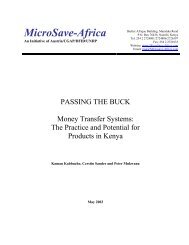You also want an ePaper? Increase the reach of your titles
YUMPU automatically turns print PDFs into web optimized ePapers that Google loves.
Betsy Marcotte<br />
came to <strong>DAI</strong> with an<br />
inherent ability to<br />
shake things up, if<br />
necessary.<br />
86<br />
When she became Vice President<br />
<strong>of</strong> <strong>DAI</strong>’s Agriculture and Natural Resources<br />
Group in 2005, Betsy Marcotte was an experienced<br />
pr<strong>of</strong>essional. She had been working<br />
at ICF during that firm’s aborted 1991 merger<br />
discussions with <strong>DAI</strong> and managed water and<br />
environmental projects for another USAID contractor.<br />
Marcotte had long been impressed with<br />
<strong>DAI</strong>, which she saw as more “mission-driven”<br />
than its competitors. But once on board, she<br />
realized that with little cross-fertilization occurring<br />
between its four practice areas, staff in<br />
her group viewed the overall company mission<br />
from widely different perspectives. A few weeks<br />
into her tenure, she scheduled a retreat to bring<br />
the group’s 50-some staff together. Certain<br />
that she would be considered an “outsider,”<br />
she approached the event with some trepidation.<br />
She soon found, however, that personal<br />
Photo by Joanne Kent, <strong>DAI</strong><br />
relationships among the staff were not as strong<br />
as she’d expected. As a result <strong>of</strong> growth and<br />
turnover, she recalled, “all <strong>of</strong> us were outsiders<br />
to some degree.”<br />
By many measures, <strong>DAI</strong> was then at the top<br />
<strong>of</strong> its game. Having won $410 million in new<br />
contract awards in the preceding year, it was<br />
on the road to becoming one <strong>of</strong> USAID’s largest<br />
implementing partners. But some important<br />
internal questions were looming: the company’s<br />
long-term ownership structure and its future<br />
leadership had not been settled. And despite<br />
measures to lower them, internal walls between<br />
business units and support <strong>of</strong>fices were only<br />
getting higher. For <strong>DAI</strong>, staying on top would<br />
require tying up these threads <strong>of</strong> uncertainty<br />
and pulling employees together at every level.<br />
Fortunately, Betsy Marcotte was just one among<br />
many leaders committed to making this happen.<br />
Ownership Dynamics<br />
and Culture<br />
From its inception, <strong>DAI</strong>’s bylaws expressed the<br />
founders’ conviction that the company should<br />
remain independent and that shareholding<br />
should be limited to current employees. By<br />
2005, the ownership circle had grown to the<br />
point that there were 70 individual shareholders,<br />
holding 33 percent <strong>of</strong> the equity, while the ESOP<br />
(the successor to the old pr<strong>of</strong>it sharing plan)<br />
held the remaining two-thirds. The advantage <strong>of</strong><br />
the ESOP was that it gave all U.S. employees<br />
a chance to participate in ownership. Shares



